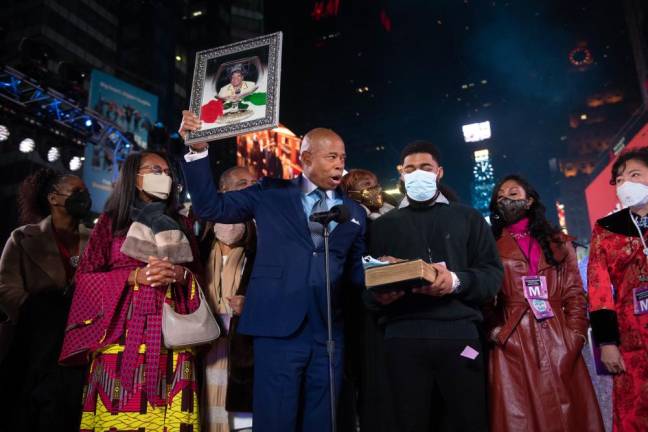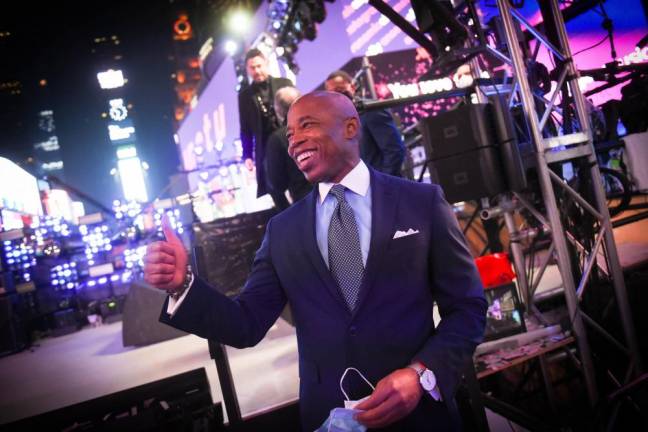New York is a great city to be rich in, it has been observed, and not the worst place to be poor, either. But the folks in the middle get slammed.
The pandemic has offered renewed evidence of this, a new report suggests.
As Eric Adams becomes mayor, he says that one of his central challenges is to supercharge the city’s sluggish economic recovery, which has badly lagged the national comeback.
Promising “a laser focus on taming COVID, turning our economy around and lowering crime,” Adams said, “we are ready for a major comeback, because this is New York.”
Everyone has advice, of course, on how to achieve that comeback.
McKinsey & Company, the consultancy, offered “insights for an inclusive economic recovery for New York City,” observing that the well-off generally fared well in the pandemic and the poor suffered badly.
“Low-income New Yorkers have been the most affected financially during the pandemic, while higher-income households have been insulated — and often even improved their financial situation,” McKinsey reported.
But both high- and low-income New Yorkers — those living in households making less than $50,000 a year or more than $100,000 — were financially affected by the pandemic roughly to the same extent as residents of other major American cities, McKinsey reported.
What McKinsey spotted was something particular to New York’s economic challenge: the losses suffered by middle-income New Yorkers, those living in households with income between $50,000 and $100,000.
“The share of middle-income New York residents who lost income during the pandemic was substantially larger than in peer cities in the United States,” McKinsey noted.
Recovery Gap
Understanding why middle-income New Yorkers took such a blow, compared to other cities, is, logically, an essential piece of getting the New York recovery back on par with the rest of the country.
New York’s recovery gap can be described in two basic numbers: 445,000 missing jobs and an 9 percent unemployment rate.
At a time when the national economy is close to recovering all the jobs lost during the pandemic, New York City is still short 445,000 jobs from its 4.7 million jobs peak in early 2020.
Similarly, the national unemployment rate, at 4.2 percent in November, is rapidly returning to the 3.5 percent jobless rate before the pandemic. Yet unemployment in New York City, at 9 percent, is still far above the 3.6 percent rate here at the start of 2020.
New Yorkers all know New York is different. But why did that difference come down so much harder on middle-income New Yorkers?
McKinsey based its findings on an online survey of 25,000 Americans, including 1,550 in the New York area. Almost one New Yorker in three reported a loss of income during the first year of the pandemic, with the poor suffering far more than the well off.
“One-third of New Yorkers earning less than $50,000 reported a decrease in income between spring 2020 and spring 2021, and only one-fifth reported an increase in income,” McKinsey reported. “Conversely, only one-fifth of New Yorkers earning more than $100,000 reported a decrease in income, while one-third reported an increase.”
This was roughly similar to the pattern in eight other big cities in the survey.
But for middle-income earners the result was starkly different. Indeed, middle-income residents in four of the eight other cities, including Atlanta, were more likely to report an increase than a decrease in income. And even in cities where more middle-income residents lost income than gained, the gap was smaller than in New York.
Global City
Some of the very factors that make New York, New York may help account for this. New York is by far the most global of American cities, depending more than others on visitors, both for tourism and travel.
Most of these jobs, many of them at low- to middle-income levels, evaporated and are coming back slowly as COVID-19 continues its rampage.
“It could be that there are a lot of respondents in their middle range where the household consists of two low-wage earners, and the greater incidence of job losses in NYC, according to all the employment data I’ve seen, could explain their middle-income finding,” suggested an expert on the New York economy, James Parrott of the New School for Social Research.
The workforce is also more global. New York has more immigrants than any other American city. “A greater share of immigrants in NYC reported a worsening financial situation than US-born New Yorkers and immigrants elsewhere in the United States,” McKinsey said. “45 percent of first-generation immigrants ... reported that their living situation in spring 2021 was less secure than in spring 2020, a full 15 percentage points higher than the city average and seven percentage points higher than the average for first-generation immigrants in peer US cities.”
The large immigrant population, many of them building a new life around small businesses, was vulnerable to the nature of the pandemic economic crash. “Our job losses were in brick-and-mortar small businesses to a large extent,” said Kathryn Wylde, President and CEO of the Partnership for New York City.
Freelance Workers
New York also has a very high proportion of gig and freelance workers, from Broadway performers to car service drivers, jobs which vanished in much higher proportion than traditional office work.
Indeed, office workers often kept their jobs and worked from home while the service workers whose jobs depended on their presence in midtown and downtown business districts lost their jobs.
“Clearly, the fact that our city economy depends on commuters (about a third of Manhattan workforce comes from outside the city) means remote work has a bigger impact here than elsewhere,” said Wylde.
McKinsey noted that hardships were compounded among those who were members of two or more of what the consultancy termed “at risk” groups.
“Hispanic/Latino immigrants were significantly more likely to report material hardship. Over half of surveyed Hispanic/Latino immigrants reported concern that they will lose their current housing, compared with about a fifth of the city overall. “
Similarly, McKinsey said, “many more Asian New Yorkers reported loss of income during the pandemic than Asian residents in peer cities in the United States.”
The newly installed Mayor Adams entered office with economic revival high on his to-do list, along with curbing crime and COVID-19. He has reached out to business leaders, who were alienated from Bill de Blasio, and he has offered a number of programs to spur the economy.
Noteworthy among these is a focus on improving the skills of job seekers to match available jobs. Adams for example has talked about the growth of tech startups and his desire to bring Bitcoin and self-driving car development to New York.
“But we must connect the industries to our educational system.” He said during his campaign. “I want these industry leaders to be connected with CUNY, as well as connected to our district and charter schools and public schools in the city.”
The McKinsey report said “the moral case for action is clear.”
“Inequities that have long existed in NYC were exposed and then exacerbated by the pandemic — these will not be alleviated without action,” the report concluded. “The evidence suggests that those who have been the hardest hit are also least able to build back — and will continue to be affected by the uncertain economic recovery. Without a targeted approach, NYC risks losing the opportunity to build a fairer society that supports the well-being of all its residents.”
“Our job losses were in brick and mortar small businesses to a large extent.” Kathryn Wylde, President and CEO, Partnership for New York City

